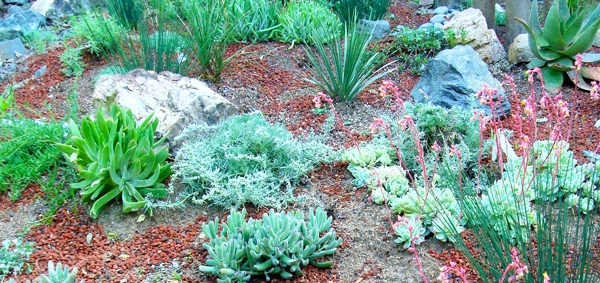
This is a guest post from Missy Gable, UC Cooperative Extension Master Gardener program; Dave Fujino, California Center for Urban Horticulture, UC Davis; Janet Hartin, UC Cooperative Extension; Chuck Ingels, UC Cooperative Extension; Loren Oki, UC Davis; and Karrie Reid, UC Cooperative Extension.
Water scarcity is part of life in California, which has been made even clearer in this fourth year of drought. The state's long-term forecast includes less snow pack and increased demand on our diminished water resources. In response, Californians are evaluating their water use, both in the landscape and the home. An obvious sign of changing landscape practices are the ‘golden' lawns that were once green. Many water districts have restricted the installation of new residential lawns and implemented “cash-for-grass” programs.
A variety of options exist for gardeners implementing landscaping changes. Trading in your turf for concrete, rock, or artificial turf are options. However, none of these selections promote healthy soils and other ecosystem services. In fact, all of these options can be problematic because they create a heat island effect and may have water infiltration or runoff issues.
Gardeners can also change the type of turfgrass they are growing. Warm-season turfgrass such as bermudagrass and buffalograss can be substituted for traditional cool-season grasses such as tall fescue and ryegrass. Warm-season turf goes dormant in fall and winter but impressively uses about 25% less water than cool-season counterparts.
Increasing the uniformity that water is applied across a lawn, fixing broken sprinkler heads, and irrigating based on climate zone can reduce water waste by 20-50%. Consult the UC ANR Lawn Watering Guide for specific information on these topics. Switching from a fan spray irrigation system to a multi-stream rotary system that waters more evenly and more slowly over the surface of your turf can also save water and decrease water and chemical runoff.
If you intend to suspend irrigation to your lawn, be sure to provide water to trees that have relied on that water. Watch trees for water stress symptoms such as change in color, wilting, or unseasonal leaf drop and provide water if necessary. As needed, apply water using a temporary drip or sprinkler device or a garden hose. Irrigate away from tree trunks in the dripline of the tree slowly and deeply. Gradually lengthen the interval between watering.
Other planted landscapes can provide similar ecosystem services to turf. For those considering a landscape conversion from turfgrass to native or Mediterranean climate-adapted plants, there are some important practices to take into consideration. These include:
- Delay conversion to a low water-use landscape to the mid-fall or early winter. New plants have small root systems and are not immediately water conserving when planted. In fact, they require quite a bit more water initially to become established in your landscape. Planting in cooler months allows root growth to begin with little added water and takes advantage of seasonal rains to support the healthy establishment of your new landscape. Be sure to select water-efficient plants that grow well in your climate.
- Control weeds. A weed is a water thief in the landscape when you have limited irrigation events. Remove weeds so they do not compete with your landscape plants for water.
- Install drip irrigation. Drip irrigation is a targeted way to ensure water is being applied directly to a plant's root zone and not ‘lost' outside the reach of those roots. Contact your local University of California Cooperative Extension (UCCE) Master Gardener Program for more information about the frequency and timing of your irrigation system. Periodically examine the soil several inches below the surface to make sure you're adding the right amount of water.
- Maintain 3-4” of shredded bark or wood chip mulch. Mulch is an insulator. It shields the soil from sunlight so weed seeds don't sprout, reduces evaporation of moisture from the soil, and protects plant roots from harmful temperatures so they don't die. Apply up to 4” deep but be sure to keep mulch several inches away from the base of tree trunks to avoid potential rot.
- Avoid overuse of fertilizers. Fertilizers increase plant growth, which in turn increases a plant's water need. When water is limited, do not apply fertilizer.
- Become familiar with your irrigation controller. You are not alone if programming your irrigation controller is a daunting task. Many people do not understand how to set their irrigation controller.Helpful tipsare available as a guide to adjusting irrigation controllers and scheduling appropriate irrigation events for your landscape.
- Consider installing a ‘laundry to landscape' graywater system. The state and most local jurisdictions have lifted or greatly lessened restrictions on graywater systems which allow irrigation of plants with water from a washing machine. Contact your local county or city public works department for specific information on local laws.
Whatever your water-saving strategy, connect with your local UCCE Master Gardener Program for information and support. Program volunteers are uniquely trained to extend University research and knowledge to California residents. They staff county phone helplines, attend local farmer's markets, and conduct public workshops. They are located in 50 counties across California and are a free and accessible service that supports Californians in creating and maintaining responsible landscapes. Many county Master Gardener web sites have extensive information about managing plants during drought.
The California Institute for Water Resources also has many links to drought tips, videos, and other useful resources.